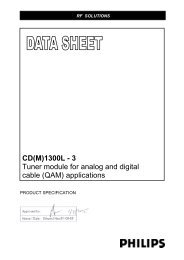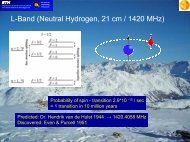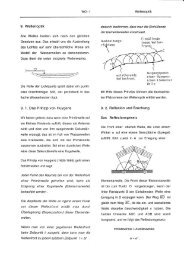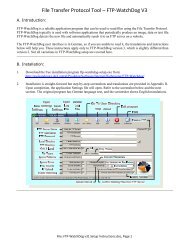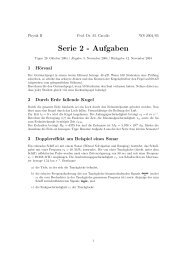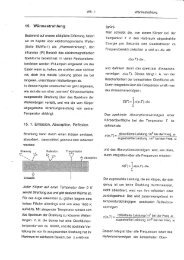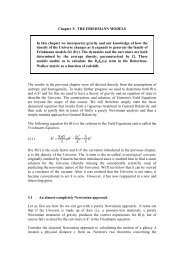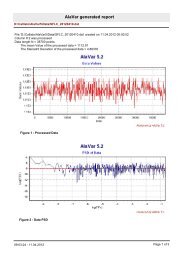here - Institute for Astronomy Umleitung
here - Institute for Astronomy Umleitung
here - Institute for Astronomy Umleitung
You also want an ePaper? Increase the reach of your titles
YUMPU automatically turns print PDFs into web optimized ePapers that Google loves.
Title: Science Case<br />
Reference: MUSE-MEM-SCI-052<br />
Issue: 1.3<br />
Date: 04/02/2004<br />
Page: 25/100<br />
global constraint that contributes little to the detailed time evolution of the reionization.<br />
Hydrogen must be essentially neutral over a substantial fraction of the z>6 universe, but the<br />
exact epoch is largely unconstrained. Using semi analytical and numerical models, the<br />
WMAP and QSO results can be put in concordance, if the universe experiences a very<br />
extended reionization history starting at z≈20 and ending at z≈6. However, the apparent high<br />
temperature of the IGM provides evidence that the energy associated with the reionization<br />
was invested at relatively late cosmic epochs (z6 are the ideal tests to further constrain the reionization history<br />
of the Universe because (i) they are the likely sources of ionizing UV photons and (ii) their<br />
abundance as a function of redshift directly probes the ionization state of the IGM. Even small<br />
fractions of neutral hydrogen are efficient in scattering Ly α photons in direction and<br />
frequency thus making faint emitters unobservable, unless the intrinsic line width is very large<br />
According to the simulations detailed in section 2.2 we expect 27 Ly α -emitters in a single<br />
MUSE deep field in the 6–6.7 redshift range. In the proposed survey of 5 deep fields (see<br />
section 2.12.1) we shall get 135 objects in total. By investigating their evolution, the<br />
reionization history can be probed near x HI ≈1, a regime that is poorly tested by Gunn-<br />
Peterson-trough measurements.<br />
Two main signatures that can be uniquely searched <strong>for</strong> with MUSE are the following:<br />
• If the neutral fraction falls considerably below levels of 1%, then the partly neutral<br />
IGM produces a Ly α damping wing that should absorb a significant part of the Ly α<br />
line, if the HII region produced by the galaxy around itself is not large enough to<br />
move the damping wing far away from the line center. Faint Ly α emitters should<br />
'disappear' rapidly beyond the reionization redshift (Haiman & Spaans 1999), while<br />
the brighter sources would still be visible (Cen & Haiman 2002). The luminosity<br />
function and its redshift evolution of the Ly α emitters contain in<strong>for</strong>mation on the<br />
neutral fraction and thus on reionization. Furthermore, any cosmic structure of larger<br />
than average density will induce infall of the IGM around it, i.e. the gas will “see” the<br />
source emission shifted to the blue, and absorbing red-ward of the Ly α line center; this<br />
effect may potentially wipe out most of the line. The optical depth owing to this effect<br />
increases roughly as (1+z) 4 (Haiman & Loeb 2002).<br />
• T<strong>here</strong> should be characteristic imprints from a partially neutral IGM on the Ly α line<br />
shape. This effect is hard to observe in a single source, but can be measured if one has<br />
a statistical samples of ≥ 100 Ly α emitters (argued in Haiman 2003) as provided by<br />
the MUSE deep fields.




